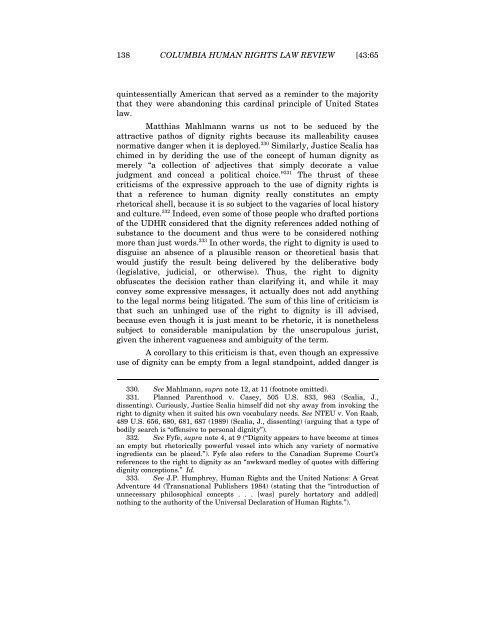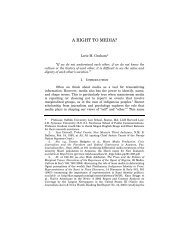The Right to Dignity Rex D. Glensy - Columbia Law School
The Right to Dignity Rex D. Glensy - Columbia Law School
The Right to Dignity Rex D. Glensy - Columbia Law School
Create successful ePaper yourself
Turn your PDF publications into a flip-book with our unique Google optimized e-Paper software.
138 COLUMBIA HUMAN RIGHTS LAW REVIEW [43:65<br />
quintessentially American that served as a reminder <strong>to</strong> the majority<br />
that they were abandoning this cardinal principle of United States<br />
law.<br />
Matthias Mahlmann warns us not <strong>to</strong> be seduced by the<br />
attractive pathos of dignity rights because its malleability causes<br />
normative danger when it is deployed. 330 Similarly, Justice Scalia has<br />
chimed in by deriding the use of the concept of human dignity as<br />
merely “a collection of adjectives that simply decorate a value<br />
judgment and conceal a political choice.” 331 <strong>The</strong> thrust of these<br />
criticisms of the expressive approach <strong>to</strong> the use of dignity rights is<br />
that a reference <strong>to</strong> human dignity really constitutes an empty<br />
rhe<strong>to</strong>rical shell, because it is so subject <strong>to</strong> the vagaries of local his<strong>to</strong>ry<br />
and culture. 332 Indeed, even some of those people who drafted portions<br />
of the UDHR considered that the dignity references added nothing of<br />
substance <strong>to</strong> the document and thus were <strong>to</strong> be considered nothing<br />
more than just words. 333 In other words, the right <strong>to</strong> dignity is used <strong>to</strong><br />
disguise an absence of a plausible reason or theoretical basis that<br />
would justify the result being delivered by the deliberative body<br />
(legislative, judicial, or otherwise). Thus, the right <strong>to</strong> dignity<br />
obfuscates the decision rather than clarifying it, and while it may<br />
convey some expressive messages, it actually does not add anything<br />
<strong>to</strong> the legal norms being litigated. <strong>The</strong> sum of this line of criticism is<br />
that such an unhinged use of the right <strong>to</strong> dignity is ill advised,<br />
because even though it is just meant <strong>to</strong> be rhe<strong>to</strong>ric, it is nonetheless<br />
subject <strong>to</strong> considerable manipulation by the unscrupulous jurist,<br />
given the inherent vagueness and ambiguity of the term.<br />
A corollary <strong>to</strong> this criticism is that, even though an expressive<br />
use of dignity can be empty from a legal standpoint, added danger is<br />
330. See Mahlmann, supra note 12, at 11 (footnote omitted).<br />
331. Planned Parenthood v. Casey, 505 U.S. 833, 983 (Scalia, J.,<br />
dissenting). Curiously, Justice Scalia himself did not shy away from invoking the<br />
right <strong>to</strong> dignity when it suited his own vocabulary needs. See NTEU v. Von Raab,<br />
489 U.S. 656, 680, 681, 687 (1989) (Scalia, J., dissenting) (arguing that a type of<br />
bodily search is “offensive <strong>to</strong> personal dignity”).<br />
332. See Fyfe, supra note 4, at 9 (“<strong>Dignity</strong> appears <strong>to</strong> have become at times<br />
an empty but rhe<strong>to</strong>rically powerful vessel in<strong>to</strong> which any variety of normative<br />
ingredients can be placed.”). Fyfe also refers <strong>to</strong> the Canadian Supreme Court’s<br />
references <strong>to</strong> the right <strong>to</strong> dignity as an “awkward medley of quotes with differing<br />
dignity conceptions.” Id.<br />
333. See J.P. Humphrey, Human <strong>Right</strong>s and the United Nations: A Great<br />
Adventure 44 (Transnational Publishers 1984) (stating that the “introduction of<br />
unnecessary philosophical concepts . . . [was] purely horta<strong>to</strong>ry and add[ed]<br />
nothing <strong>to</strong> the authority of the Universal Declaration of Human <strong>Right</strong>s.”).















